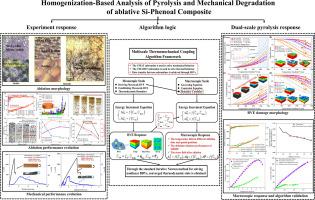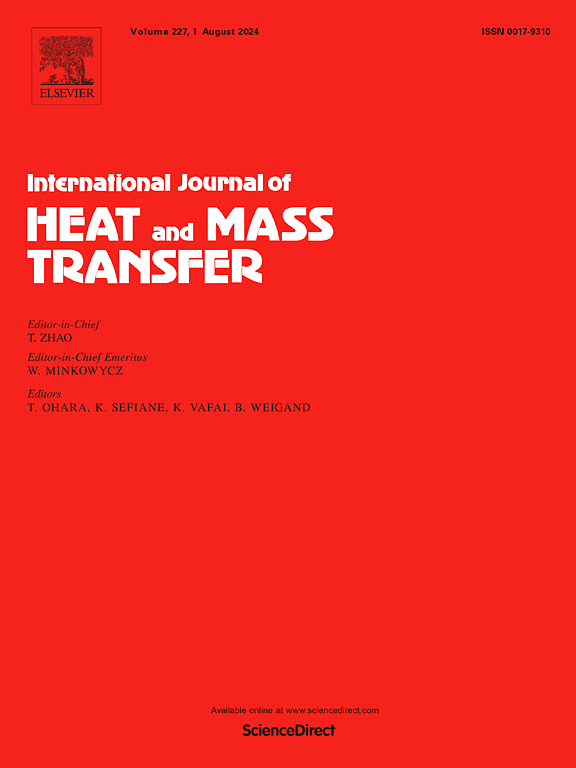基于均质化的烧蚀硅纤维增强酚醛树脂复合材料热解和机械降解分析
IF 5
2区 工程技术
Q1 ENGINEERING, MECHANICAL
International Journal of Heat and Mass Transfer
Pub Date : 2024-10-29
DOI:10.1016/j.ijheatmasstransfer.2024.126328
引用次数: 0
摘要
硅纤维增强酚醛树脂复合材料(SiFPRC)具有优异的绝缘性能和抗烧蚀性能,被广泛应用于高超音速飞行器的热保护系统(TPS)和结构材料中。在极端热条件下,物理化学烧蚀过程(包括严重的局部热传导、分解和结构破坏)会导致热机械性能的复杂变化。本研究开发了一种基于均质化的热力学模型,用于研究 SiFPRC 的微烧蚀特性以及由此导致的整体机械退化。首先,通过氧乙炔烧蚀实验和结合高精度 CT 技术的力学性能测试,对烧蚀率和孔隙率演变进行了实验分析。在非平衡耗散热力学的框架内,开发了一个跨尺度一致的热力学模型,该模型集成了 SiFPRC 的热传导和热解反应特性,并通过非线性有限元算法得以实现。通过与实验结果对比进行校准和验证后,所建立的模型被用于研究多种热耗散机制,包括酚醛树脂的热分解、热阻断效应、硅纤维中的相变、碳-硅反应和机械降解。这项研究为开发和应用高性能 TPS 材料提供了有力的理论支持和设计基础。本文章由计算机程序翻译,如有差异,请以英文原文为准。

Homogenization-based analysis of pyrolysis and mechanical degradation of ablative silica fiber-reinforced phenolic resin composites
Silica fiber-reinforced phenolic resin composites (SiFPRCs), characterized by exceptional insulative properties and ablation resistance, are widely utilized in thermal protection systems (TPS) and structural materials for hypersonic vehicles. Under extreme thermal conditions, the physicochemical ablative processes, including severe local thermal conduction, decomposition, and structural failure, lead to complex variations in thermomechanical properties. This study developed a homogenization-based thermomechanical model to investigate the micro-ablation characteristics of SiFPRCs and the resultant overall mechanical degradation. The ablation rate and porosity evolution were experimentally analyzed firstly, through oxyacetylene ablation experiments and mechanical property tests coupled with high-precision CT technology. Within the framework of non-equilibrium dissipative thermodynamics, a cross-scale consistent thermomechanical model integrating heat conduction and pyrolysis reaction characteristics of SiFPRCs was developed and implemented through a nonlinear finite element algorithm. After calibration and validation through comparison with experimental results, the developed model was applied to examine multiple thermal dissipation mechanisms, including thermal decomposition of phenolic resin, heat blocking effects, phase transitions in silica fibers, carbo-silicon reactions, and mechanical degradation. This research provides robust theoretical support and a design foundation for the development and application of high-performance TPS materials.
求助全文
通过发布文献求助,成功后即可免费获取论文全文。
去求助
来源期刊
CiteScore
10.30
自引率
13.50%
发文量
1319
审稿时长
41 days
期刊介绍:
International Journal of Heat and Mass Transfer is the vehicle for the exchange of basic ideas in heat and mass transfer between research workers and engineers throughout the world. It focuses on both analytical and experimental research, with an emphasis on contributions which increase the basic understanding of transfer processes and their application to engineering problems.
Topics include:
-New methods of measuring and/or correlating transport-property data
-Energy engineering
-Environmental applications of heat and/or mass transfer

 求助内容:
求助内容: 应助结果提醒方式:
应助结果提醒方式:


